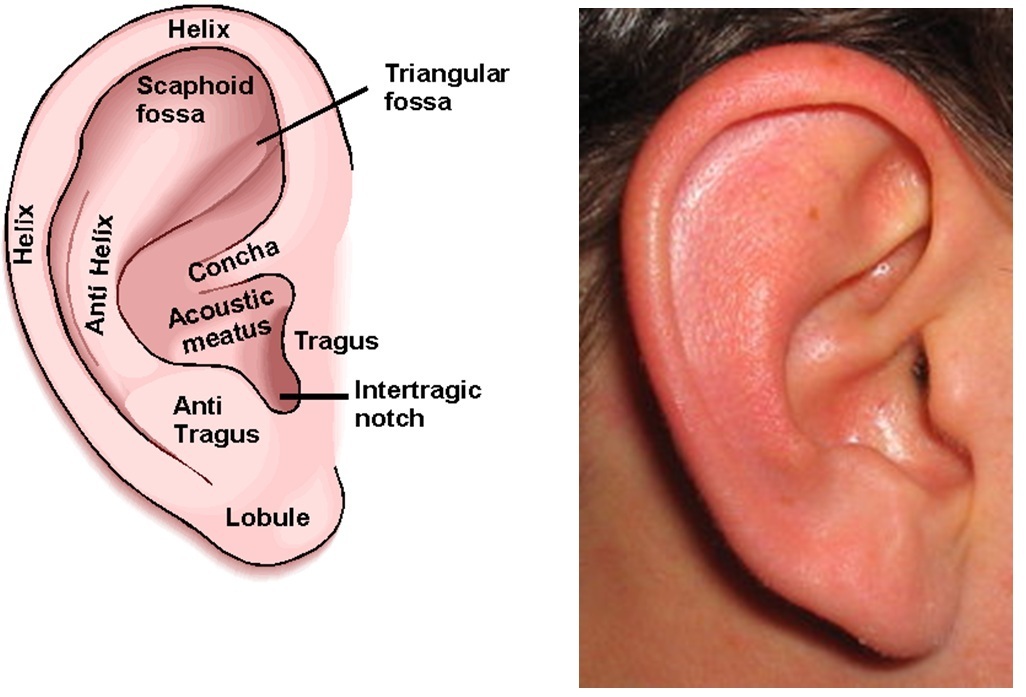The Ear
The external ear
consists of
Auricle (Pinna)
External acoustic meatus.
The auricle
Expanded portion projecting from the side of the head
Fibroelastic cartilage covered with skin
Grooved and ridged
Outer ridge is called helix.
Ear Lobule : soft, pliable, made of fibrous tissue and fat
The External acoustic meatus (auditory canal)
lateral third is cartilaginous
Medial two third is bony and is in the temporal bone
meatus is lined with hairy skin
sebaceous and ceruminous glands in the skin of the lateral thrid ; ceruminous glands produce wax
tympanic membrane separtes the external acoustic meatus from the middle ear.
The tympanic membrane three layers
outer covering of hairless skin
the middle layer of fibrous tissue
the inner layer of mucous membrane continuous with that of the middle ear.
The middle ear
(Tympanic Cavity )
The portion within the petrous portion of the temporal bone.
Structure
Lined by simple or cuboidal epithelium
Filled with air
Air reaches through the pharyngotympanic tube (Eustachian Tube)
( auditory or Eustachian ) tube which extends from the nasopharynx.
Eustachian tube 4 cm long - ciliated epithelium
Air pressure in the external ear and the middle ear are made equal by the eustachian tube.
This equalization helps vibration of the tympanic membrane by sound waves.
Boundaries
Laterally - tympanic membrane
Roof and floor - temporal bone
Posteriorly -temporal bone - openings - mastoid antrum - mastoid air cells.
Medial wall - temporal bone- two openings : oval window (fenestra vestibuli)
Round window (fenestra cochleae)
Oval window is occluded by stapes and the round window by a fine sheet of fibrous tissue.
Auditory ossicles
Three very small bones
Extend from the tympanic membrane to the oval window
Movabel joints
They are the
- Malleus - hammer shaped - handle is in contact with the tympanic membrane and the head joints with incus
- Incus - anvil shaped - body joints with the malleus and the long process joints with stapes
- Stapes - stirrup shaped - head joints incus, footplate fits into the oval window.
The Internal Ear
The portion of the ear which contains the organs of hearing and balance
Two parts bony labyrinth and membranous labyrinth
Bony labyrinth
A cavity within the temporal bone with periosteum
Membranous labyrinth
A membranous bag inside the bony labyrinth
Between the bony labyrinth and the membranous labyrinth there is a fluid called perilymph
Inside the membranous labyrinth - fluid - endolymph.
The parts of the bony labyrinth are :-
vestibule
cochlea
semicircular canals
Vestibule - Part nearest the middle ear - Contains oval and round windows in its lateral wall.
Cochlea -- Snail shaped - Broad base --Continues with vestibule - Spirals +
The Semicircular Canals -- 3 tubes - one in each of the three planes of space -they are continuous with the vestibule
Membranous Labyrinth
This membranous sac is separated from the bony labyrinth by perilymph. It contains endolymph
The parts of the membranous labyrinth are
The vestibule containing the Utricle & Saccule,
The Cochlea
The semicircular canals - anterior, posterior and lateral
The membranous cochlea contain
basilar membrane with neuroepithelial cells and their nerve fibres
organ of Corti - sensory - sound observed through the nerve hearing is transmitted to the brain.
Tympanic Cavity : Auditory Ossicles
- Describe the structure of the ear.
- Short notes on structure and functions of middle ear and vestibular apparatus






